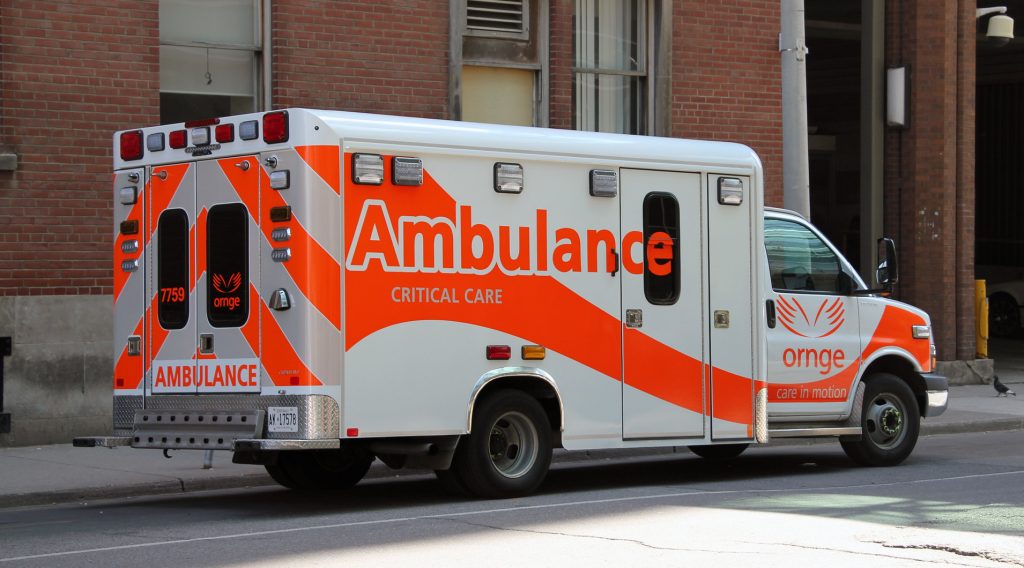Chapter 9: Transfer and Discharge Procedures
Booking Patient Transportation

The HUC may spend a substantial amount of their time booking transportation for patients who are booked for tests or consultations at other facilities during their stay or require transportation to return to their home in the community, or long-term care facility at discharge. The HUC will work closely with the clinical resource nurse and other members of the discharge planning team to ensure that the appropriate type of transfer is booked, the timing is appropriate, and the required clinical and demographic details are outlined for the transfer crew.
Step 1: Acquiring Transportation Approval
In some jurisdictions, like Ontario, all patients being transported between facilities require authorization prior to transfer in order to limit the spread of infectious diseases (Thompson, 2018). In Ontario, this authorization is by the Provincial Transfer Authorization Centre (PTAC). Each hospital has its own unique login and account on the provincial authorization site to streamline the request process.
The HUC must complete an online transfer request for every time a patient requires a transfer to another facility. Transfer requests typically include sending and receiving facility information and clinical screening information for the patient. The HUC will receive a confirmation notification once the transfer is approved, with a unique transfer confirmation number on it (in Ontario, this is called the MT#). Straightforward requests are usually confirmed within minutes; however, complicated requests may take longer to process or may be rejected. The authorization number is typically valid for 24 hours and only covers the single or round-trip transfer.
Step 2: Booking Transportation
Once the HUC has obtained transfer authorization, they may then book the patient transfer. The type of transportation service booked depends upon the patient’s medical requirements.
Non-Emergency Medical Transport Services
Although there may be several non-emergency medical transport services (NEMTS) in a geographic area, most hospitals contract with one or two service providers to provide the bulk of their routine transfers. Non-emergency transport services may provide a variety of transfer options including wheelchair transfer or stretcher transfer – the discharge planning case worker or the clinical resource nurse will direct the HUC on which type of service to book. Once the HUC has ascertained the trip details, they may book the trip online through a booking portal. They will need to provide:
- transfer authorization number (MT#),
- date and time of transfer, including whether a return trip is required,
- address of transfer, including whether there are stairs,
- clinical information for the patient, including weight and isolation status, and
- escorts or equipment that will be required.
Hospitals typically cover the cost of NEMTS for patients attending testing at another facility; however, they may not cover the cost of patient transportation home. The HUC may be required to provide billing details in these cases, as well as relay any costs to patients and/or their families.
Urgent Patient Transfer Services (Ambulance, Air Ambulance)
Ambulance services should be used only in the case of urgent conditions, such as patients who require immediate transfer, monitoring, medications and/or blood products, specialized equipment, such as a ventilator or external pacemaker, or patients at risk for loss of limb or life (ORNGE, 2024).
The booking procedure for urgent land transfers is similar to non-urgent transfers; however, the booking is usually taken over the telephone with the local EMS services’ ambulance operator. The HUC or nurse is expected to answer questions about patient severity, patient information, and clinical information. Most jurisdictions have an exception for very urgent cases, such as loss of life or limb. In Ontario, the sending facility can arrange life or limb transfer by contacting CritiCall, which may arrange air ambulance or specialized ground transfer with ORNGE (Ontario’s designated air and critical care ambulance services)(ORNGE, 2024).
Learn more about what’s required for booking transfers in Ontario on the “Booking a Patient Transport” checklist from ORNGE [PDF].
Take Note! — Advance Directives and Transportation
It is important that the HUC make a copy of a patient’s advanced directives or DNR (if one has been completed) for the transfer service providers to provide them with direction in case the patient experiences a life-threatening event during the transfer.
Practice Activity: Transfer, Discharge, and Transportation
Part 1
Part 2
References
ORNGE. (2024). Transporting a patient.
Thompson, V. D. (2018). Administrative and clinical procedures for the Canadian health professional (4th ed.). Pearson Canada.
Attributions
“Ornge ambulance” by Can Pac Swire on flickr; Creative Commons – Attribution-NonCommercial 2.0 Generic.
legal documents that communicate a person’s wishes about health care decisions in the event they become incapable of making health care decisions (either permanently or temporarily)

